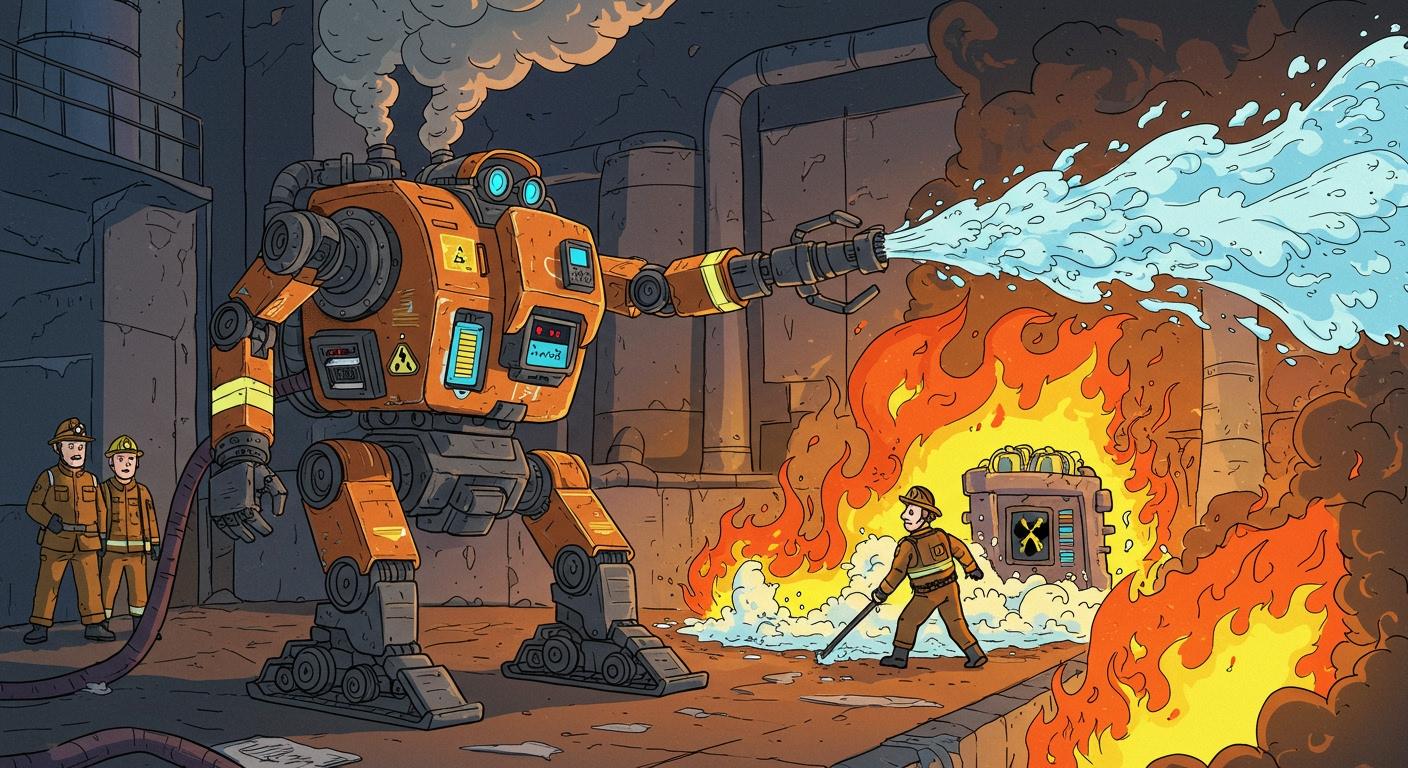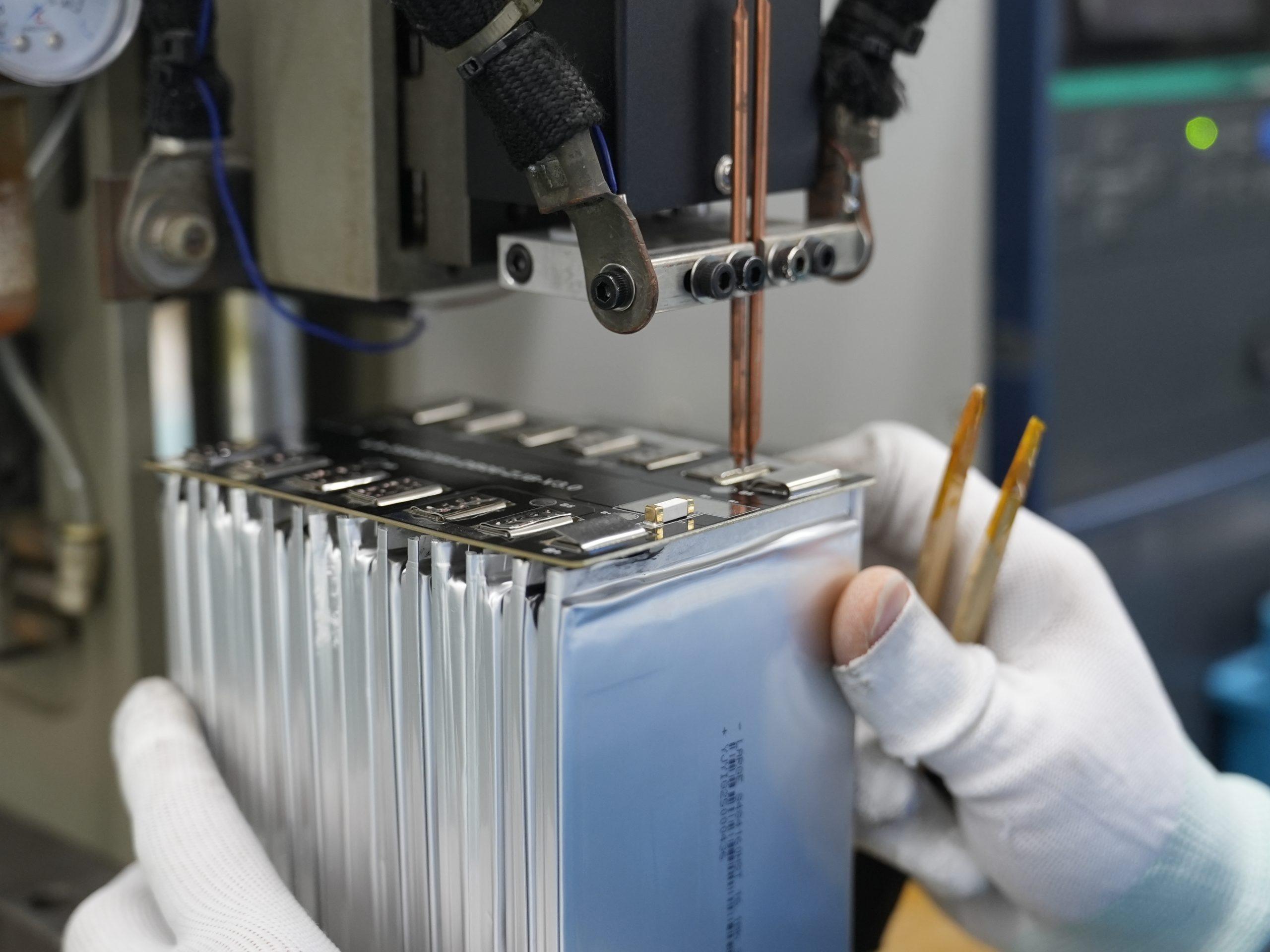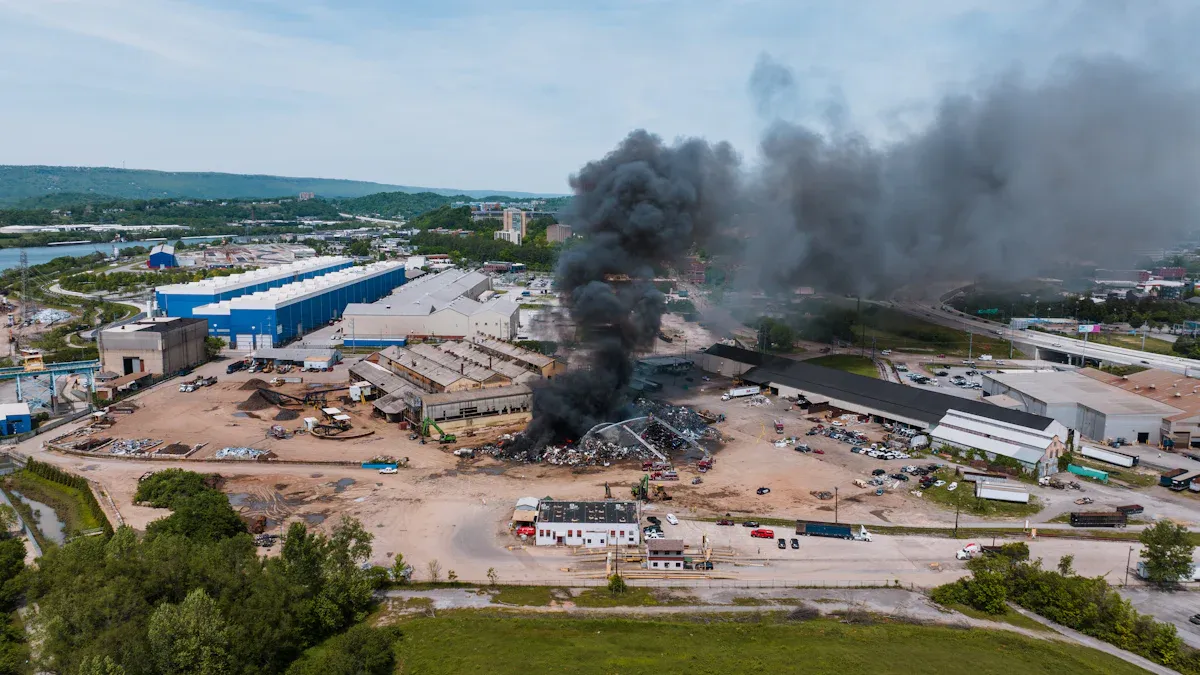
When you deploy robots into blazing environments, battery technology becomes the backbone of their performance. High temperatures, unpredictable hazards, and the demand for rapid response push your systems to their limits. You rely on advanced batteries to maintain firefighting operations, ensuring safety for both machines and people in dangerous settings.
Key Takeaways
Battery technology ensures reliable power for firefighting robots, allowing them to operate continuously in extreme conditions. Choose lithium batteries like LiFePO4 and NMC for stable performance.
Safety is crucial when using batteries in firefighting. Follow strict guidelines for handling damaged batteries and ensure personnel are trained to manage battery-related incidents.
Autonomous operation in hazardous areas is possible with advanced battery technology. Select batteries that support extended autonomy to keep human responders safe.
High energy density batteries maximize the runtime of firefighting robots. Opt for batteries that can carry heavier payloads and perform complex tasks efficiently.
Integrate advanced battery management systems to monitor battery health and prevent overheating. This enhances safety and extends the operational life of firefighting robots.
Part 1: Battery Technology Role
1.1 Power Reliability
You depend on battery technology to deliver consistent power in the most demanding firefighting scenarios. Lithium battery packs, such as LiFePO4 and NMC chemistries, provide stable voltage and high cycle life, which are essential for robots that must operate without interruption. Reliable power ensures that your robots can navigate through smoke, debris, and intense heat, maintaining critical functions like water spraying, sensor operation, and communication. In industrial and security applications, this reliability translates to fewer mission failures and greater trust in autonomous systems.
1.2 Operational Safety
Battery technology plays a direct role in the safety of both your robots and personnel. You must follow strict standards to prevent operational hazards. The table below outlines key safety aspects for batteries used in firefighting robots:
Safety Aspect | Description |
|---|---|
Damaged Batteries | Require special precautions and training for recycling or disposal. |
Incident Preparedness | A pre-defined emergency plan should be in place for damaged or overheating batteries. |
Fire Response | Only trained personnel should fight battery fires, using appropriate PPE and extinguishing methods. |
Training | Personnel need up-to-date training to recognize hazards and take precautions. |
By adhering to these standards, you reduce the risk of battery-related incidents during firefighting missions. This approach protects your investment in robotics and ensures compliance with industry regulations.
1.3 Autonomy in Hazardous Areas
Firefighting robots must operate independently in environments where human access is limited or impossible. To achieve this, you require battery technology that supports extended autonomy. Key specifications include:
An 8V battery platform, which powers the robot and enables autonomous operation in hazardous areas.
With the right battery technology, your robots can perform tasks such as mapping fire zones, delivering supplies, or monitoring structural integrity. This autonomy increases the effectiveness of firefighting efforts and keeps human responders out of harm’s way.
Part 2: Battery Requirements
2.1 High-Temperature Resistance
You face extreme heat when deploying robots in firefighting missions. Battery technology must withstand these harsh conditions to keep your equipment running. Lithium battery packs, such as LiFePO4 and NMC, offer better thermal stability compared to older chemistries. You see these batteries used in industrial robots, security systems, and medical devices that operate in challenging environments. High-temperature resistance ensures your robots do not lose power or suffer damage during critical firefighting operations.
Tip: Always select batteries with proven performance in high-temperature scenarios. This reduces the risk of failure and increases operational safety.
2.2 Energy Density
You need batteries with high energy density to maximize the runtime and effectiveness of your firefighting robots. High energy density allows your robots to carry heavier payloads, operate longer, and perform more complex tasks. You find this requirement in medical equipment, infrastructure monitoring, and consumer electronics, where compact power sources are essential.
Here is a comparison of common lithium battery chemistries used in firefighting robots:
Chemistry | Platform Voltage (V) | High Energy Density (Wh/kg) | Cycle Life (cycles) |
|---|---|---|---|
LiFePO4 | 3.2 | 90-140 | 2000+ |
NMC | 3.7 | 150-220 | 1000-2000 |
LCO | 3.7 | 150-200 | 500-1000 |
LMO | 3.7 | 100-150 | 300-700 |
LTO | 2.4 | 70-110 | 7000+ |
Solid-State | 3.7 | 250+ | 2000+ |
Lithium Metal | 3.7 | 350+ | 1000+ |
You see that NMC and solid-state batteries provide higher energy density, which is ideal for firefighting robots that need extended operation. LiFePO4 offers excellent cycle life and safety, making it suitable for repeated use in hazardous areas.
2.3 Fast Charging
You must minimize downtime during firefighting missions. Fast charging technology helps you keep robots ready for action. Modern charging docks feature automatic takeoff, landing, and self-charging functions. You benefit from payload-swapping structures that allow quick exchange of drone payloads, boosting operational efficiency. Enhanced charging efficiency comes from upgraded centering bars and charging pads, which optimize charging speeds. Containerized designs improve transport convenience and adapt to various terrains, reducing production costs.
Feature | Description |
|---|---|
Charging Dock Size | 6 meters long, 2.5 meters wide, 2.6 meters high, designed for heavy-duty drones. |
Automatic Functions | Capable of automatic takeoff, landing, and self-charging. |
Payload-Swapping Structure | Allows for quick exchange of drone payloads, enhancing operational efficiency. |
Enhanced Charging Efficiency | Upgraded centering bars and charging pad for optimized charging speeds. |
Containerized Design | Improves transport convenience and reduces production costs, adaptable to various terrains. |
Overall Impact | Reduces downtime for firefighting operations. |
You see these advancements in industrial and infrastructure applications, where rapid deployment is critical.
2.4 Durability
You require batteries that last through repeated cycles and harsh conditions. Durability ensures your robots perform reliably in firefighting, security, and industrial settings. Advanced battery management systems monitor battery health, predict failures, and optimize usage. You benefit from safety features like fire-retardant materials and redundant power systems, which protect your robots and maintain continuous operation.
Durability Checklist for Firefighting Robots:
Use batteries with high cycle life (LiFePO4, LTO, solid-state).
Implement battery management systems for real-time monitoring.
Select fire-retardant materials for added safety.
Design redundant power systems to prevent mission failure.
You see these practices in medical and consumer electronics sectors, where reliability and safety are top priorities.
Part 3: Innovations in Battery Technology

3.1 Lithium-Ion Advances
You see rapid progress in lithium-ion battery technology, which directly improves the performance of firefighting robots. These batteries deliver high energy density and reliable power, making them the preferred choice for industrial, security, and medical applications. Recent innovations focus on safety and thermal management, which are critical in firefighting environments.
Innovation | Description | Application Scenario |
|---|---|---|
FCL-X Agent (Full Circle Lithium) | Neutralizes complex chemical reactions during lithium-ion battery fires, absorbs heat, and mitigates thermal runaway. | Firefighting robots, industrial safety |
ABS Simulation Model | Predicts thermal runaway in lithium-ion batteries, helping you develop effective firefighting strategies. | Security, infrastructure |
Advanced Extinguishing Agents | Absorb heat and reduce chemical reactions, enhancing firefighting capabilities. | Medical, robotics |
Lithium-ion batteries offer a balance between rechargeability and performance. You benefit from their ability to hold more power and last longer than other battery types. Primary lithium batteries have a longer shelf life but cannot be recharged easily. Lithium-ion batteries, as secondary cells, allow for multiple charge cycles and feature integrated monitoring systems. However, you must address their vulnerability to fires and explosions caused by short circuits and thermal runaway. This risk makes safety features and advanced management systems essential for firefighting robots.
Note: Always select lithium battery packs with robust safety mechanisms for firefighting robots. This reduces operational risks and improves reliability in hazardous environments.
3.2 Solid-State Batteries
You gain significant advantages when you use solid-state batteries in firefighting robots. These batteries store three to four times more energy per unit weight compared to conventional lithium-ion batteries. The solid electrolyte inside these batteries reduces the risk of fires, which is a major concern in firefighting scenarios.
Increased energy density boosts robot runtime and payload capacity.
Safety improvements lower the chance of battery fires during firefighting missions.
Flexible packaging allows you to fit batteries into compact robotic designs.
Extreme temperature operation ensures reliable performance in harsh firefighting environments.
Battery Type | Combustion Behavior | Safety Features |
|---|---|---|
Sulfide Solid-State | Emits vivid magenta flame | Lacks intrinsic safety under heat |
Solid Polymer Electrolytes | Ignite with intense flames | Flammable hydrocarbon components |
Oxide-Based All Ceramic | No visible combustion | Intrinsic non-combustibility, exceptional thermal stability |
You see that oxide-based all ceramic solid-state batteries provide the highest level of safety and thermal stability. The Active Safety Mechanism (ASM) in advanced solid-state batteries stabilizes the cathode and neutralizes lithium’s reactivity. This prevents violent side reactions and thermal runaway, which are critical for firefighting robots operating in extreme conditions.
3.3 Battery Management Systems
You rely on battery management systems (BMS) to enhance the reliability and safety of firefighting robots. BMS monitor and control charging, discharging, and cell balancing. These systems detect faults early and optimize battery usage, which is vital for continuous operation in industrial, security, and infrastructure settings.
Component | Description |
|---|---|
Battery Management Systems | Ensure proper monitoring and control of charging, discharging, and cell balancing. |
A robust BMS helps you prevent overheating and manage energy distribution. You can predict failures before they occur, reducing downtime and maintenance costs. In firefighting robots, BMS play a key role in maintaining operational safety and extending battery life.
Tip: Always integrate advanced BMS in your firefighting robots to maximize safety and performance. If you need more information on BMS technology, consult authoritative sources such as Nature or Science.
You see these innovations transforming firefighting operations. Lithium-ion advances, solid-state batteries, and intelligent BMS work together to improve robot autonomy, safety, and efficiency. You can deploy robots in medical, industrial, and security environments with greater confidence, knowing that battery technology supports mission-critical tasks.
Part 4: Firefighting Drones Impact

4.1 Drone Battery Needs
When you deploy firefighting drones, you must consider specific requirements for firefighting drones to ensure mission success. You need battery power systems with high-capacity energy storage, which allows drones to fly longer and complete multiple tasks over fire zones. Thermal stability is critical because firefighting drones operate in high-temperature environments. Advanced lithium-ion chemistries like LiFePO4 and NMC, combined with battery management systems, help regulate temperature and prevent overheating. You rely on batteries that function reliably under extreme conditions, maintaining voltage and current supply for continuous operation.
Thermal stability keeps firefighting drones safe in hot environments.
High-capacity energy storage supports extended flight missions.
Battery management systems balance cells and prevent thermal runaway.
Redundant battery power systems play a vital role in firefighter safety. If one battery fails, the drone switches to a backup, preventing sudden power loss and ensuring uninterrupted firefighting support.
Tip: Always choose battery power systems with built-in redundancy to minimize downtime and maximize firefighter safety.
4.2 Flight Time and Payload
You measure the effectiveness of firefighting drones by their flight time and payload capacity. Most firefighting drones achieve an average flight time between 30 and 50 minutes using current lithium battery packs. When you increase payload weight, such as adding thermal cameras or fire suppression equipment, you must balance operational efficiency. Heavier loads drain batteries faster and reduce flight time. A 10% increase in weight can decrease flight time by 20-30%. You need to optimize battery power systems to support both long flights and heavy payloads.
Increased weight reduces flight time.
Heavier payloads require more battery power.
Efficient battery power systems help maintain operational performance.
Performance Metric | Description |
|---|---|
Power Optimization | Ensures even charging and discharging of battery cells. |
Thermal Regulation | Prevents overheating during operations in high-temperature environments. |
Safety Management | Detects faults or imbalances to prevent catastrophic failures. |
Real-Time Monitoring | Provides live battery status, predicts remaining flight time, and warns of potential risks. |
Balancing Power Draw | Prevents sudden voltage drops that could lead to flight instability. |
Adaptive Thermal Management | Adjusts charging/discharging rates based on battery temperature. |
Fail-Safe Protocols | Initiates controlled landings if critical battery thresholds are reached. |
4.3 Real-World Applications
You see firefighting drones used in many industries, including medical, security, infrastructure, and industrial sectors. These drones support fire prediction and management by providing real-time aerial views and data. You use them for fire suppression, delivering water or fire-retardant chemicals to hotspots. Battery power systems with redundancy and advanced management features ensure drones maintain situational awareness and continue operating during emergencies. You rely on firefighting drones to improve firefighter safety and enhance fire prediction and management in complex environments.
Firefighting drones deliver supplies and monitor fire zones.
Battery power systems enable continuous operation and rapid response.
You achieve better firefighter safety and mission efficiency with reliable battery technology.
You rely on advanced lithium battery packs to power firefighting robots and drones, supporting safe and efficient operations in medical, robotics, security, and industrial sectors. Ongoing innovations in battery systems, such as improved energy density and real-time data monitoring, enhance situational awareness and emergency response. You benefit from data analytics that optimize battery use and predict failures. Looking ahead, you will see trends like hybrid power systems, solar integration, and better data analytics, all driving longer missions and smarter, safer firefighting.
FAQ
What lithium battery chemistries work best for firefighting robots?
You benefit most from LiFePO4, NMC, and solid-state batteries. These chemistries offer high energy density, long cycle life, and strong thermal stability. You see them used in robotics, medical devices, and industrial equipment.
How do battery management systems improve safety?
You rely on battery management systems to monitor charging, balance cells, and detect faults. These systems help prevent overheating and predict failures. You use BMS in security, infrastructure, and consumer electronics for safer operations.
Tip: Always choose robots with advanced BMS for mission-critical tasks.
Can lithium battery packs withstand extreme heat?
You select lithium battery packs like LiFePO4 and NMC for their thermal stability. These batteries operate reliably in high-temperature environments, such as firefighting, industrial, and medical settings.
How does battery technology affect drone flight time?
You achieve longer flight times with high energy density batteries, such as NMC and solid-state. Payload weight impacts battery drain. You optimize battery systems for drones in security, infrastructure, and industrial sectors.
Chemistry | Typical Flight Time (min) | Application Scenario |
|---|---|---|
NMC | 30–50 | Security, Infrastructure |
Solid-State | 50+ | Industrial, Robotics |
Why is redundancy important in battery systems?
You depend on redundant battery systems to prevent sudden power loss. If one battery fails, your robot or drone switches to a backup. This feature supports continuous operation in medical, security, and industrial missions.






